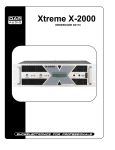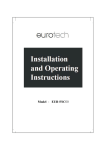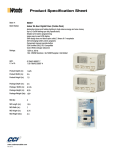Download PCIe2-2711 User`s Manual
Transcript
PCIE2-2711 PCIE GEN2 EXPANSION SYSTEM USER’S MANUAL The information in this document has been carefully checked and is believed to be entirely reliable. However, no responsibility is assumed for inaccuracies. Furthermore, Cyclone Microsystems, Inc. reserves the right to make changes to any products herein to improve reliability, function, or design. Cyclone Microsystems, Inc. neither assumes any liability arising out of the application or use of any product or circuit described herein, nor does it convey any license under its right or the rights of others. Revision 1.0, May 2012 Cyclone P/N 800-2711 Copyright 2012 by Cyclone Microsystems, Inc. CONTENTS CHAPTER 1 1.1 INTRODUCTION ..............................................................................................................................1-1 1.2 SPECIFICATIONS............................................................................................................................1-3 1.3 STANDARDS ...................................................................................................................................1-4 1.4 ORDERING INFORMATION ............................................................................................................1-5 1.5 CYCLONE ORDERING PART NUMBERS ......................................................................................1-5 CHAPTER 2 2.1 THEORY OF OPERATION ..............................................................................................................2-1 CHAPTER 3 3.1 PCIE2-2711 CHASSIS .....................................................................................................................3-1 3.2 SEATING OF CARDS ......................................................................................................................3-1 3.3 CHASSIS COOLING ........................................................................................................................3-2 3.4 CHASSIS POWER ...........................................................................................................................3-2 3.4.1 1250W Power supply Option ...............................................................................................3-2 3.4.2 2180W/3240W Power Supply Options ................................................................................3-2 3.5 LIGHT LOADING..............................................................................................................................3-2 3.6 POWER CONSIDERATIONS...........................................................................................................3-3 3.7 PCI-E AUXILARY POWER CONNECTORS ....................................................................................3-4 CHAPTER 4 4.1 SYSTEM POWER UP ......................................................................................................................4-1 4.2 SEATING OF CARDS ......................................................................................................................4-1 4.3 PCIe2-426 HOST BUS CABLE ADAPTER ......................................................................................4-1 4.3.1 PCIe2-426 Power ................................................................................................................4-1 4.3.2 PCIe2-426 Mechanical ........................................................................................................4-1 4.3.3 PCIe2-426 LED Indicators...................................................................................................4-2 4.3.4 PCIe2-426 Output Swing, De-Emphasis and Receive Equalization....................................4-2 4.4 PCIE-436 UPSTREAM CABLE ADAPTER ......................................................................................4-2 4.4.1 PCIe-436 Power ..................................................................................................................4-2 4.4.2 PCIe-436 Mechanical ..........................................................................................................4-3 4.4.3 PCIe-436 LED Indicators.....................................................................................................4-3 4.4.4 PCIe-436 Output Swing, De-Emphasis and Receive Equalization......................................4-3 4.5 LINK INDICATION - LED DEFINITION PCIe-460 ............................................................................4-3 4.6 SYSTEM MONITOR BOARD ...........................................................................................................4-4 CHAPTER 5 5.1 i PHYSICAL CONFIGURATION.........................................................................................................5-1 PCIe2-2711 PCI Express Gen2 Expansion System User’s Manual Revision 1.0, May 2012 CONTENTS LIST OF FIGURES Figure 1-1. PCIe2-2711 Block Diagram .................................................................................................1-2 Figure 5-1. PCIe2-460 Physical Configuration.......................................................................................5-1 Figure 5-2 PCIe2-426 LEDs..................................................................................................................5-2 Figure 5-3 PCIe2-426 Physical Configuration.......................................................................................5-2 Figure 5-4 PCIe-436 LEDs....................................................................................................................5-3 Figure 5-5 PCIe-436 Physical Configuration.........................................................................................5-3 Figure 5-6 PCIe2-2711 5U Chassis ......................................................................................................5-4 LIST OF TABLES Table 1-1. Table 1-2 Table 1-3 Table 1-4 Table 3-1. Table 3-2 Table 3-3 Table 3-4 Table 3-5 Table 3-6 Table 4-1 Table 4-2 ii Physical/Environmental Characteristics ..............................................................................1-3 3240W N+1 Redundant Power Supply Characteristics .......................................................1-3 2180W N+1 Redundant Power Supply Characteristics .......................................................1-4 1250W Power Supply Characteristics .................................................................................1-4 Slot Capabilities...................................................................................................................3-1 1250W Power Supply Minimum Loading.............................................................................3-3 2180W/3240W Power Supply Minimum Loading ................................................................3-3 PCIe2-460 Power Requirements.........................................................................................3-3 PCIe2-426 Power Requirements.........................................................................................3-4 Power Supplied Per PCIe Slot.............................................................................................3-4 PCIe2-426 Default DIP Switch Configuration ......................................................................4-2 Link LED Indication..............................................................................................................4-4 PCIe2-2711 PCI Express Gen2 Expansion System User’s Manual Revision 1.0, May 2012 CHAPTER 1 INTRODUCTION 1.1 INTRODUCTION The Cyclone Microsystems PCIe2-2711 is a PCI Express (PCIe) Gen2 expansion system that allows the user to add up to eight double width PCI Express add-in-cards. Most PCs contain few PCI Express slots making them poorly suited for embedded systems requiring many different I/O boards and co-processor resources. The PCIe2-2711 Expansion System has been designed for applications using multiple GPUs and other high-powered PCIe devices. The PCIe2-2711 PCI Express Expansion System permits system developers to use powerful and costeffective PCs as a foundation for a robust embedded system. The eight PCI Express slots are organized as two expansion segment sides, each with four x16 slots and a x16 cable to the host. All expansion slots accommodate double width, full length and full height cards and are cooled by four 77 CFM fans. The PCIe2-2711 is available with either a 3240 W or 2180 W N+1 redundant power supply in a 5U chassis, or a 1250 W standard ATX supply in a 4U chassis. The Expansion System supports 160 Gb/s bi-directional traffic to and from the host system. The system utilizes repeaters and non-blocking PCI Express switches for excellent peer-to-peer I/O bandwidth. For PCs with modern BIOSs, the PCIe2-2711 Expansion System is recognized by the host system upon boot-up, requires no hardware specific drivers and is entirely host operating system agnostic. The PCIe2-2711 system is composed of three elements: PCI Express Host Bus Cable Adapters, Expansion System Cables and an Expansion Chassis. The PCIe-426 Host Bus Cable Adapter card is to be inserted into a host computer’s x16 PCIe Gen2 slot. The x16 PCIe expansion cable links the PCI host with the expansion chassis. The expansion chassis is populated with the PCIe-460 Switched Backplane, two PCIe-436 Upstream Cable Adaptors and, optionally, a System Monitor board. PCI Express is a high performance, general purpose I/O inter-connect defined for a wide variety of computing and communication platforms. Key PCI attributes, such as its usage model, load-store architecture, and software interfaces are maintained, whereas its parallel bus implementation is replaced by a serial interface. PCI Express take advantage of recent advances in point-to-point inter-connects, switchbased technology, and packetized protocol to deliver new levels of performance. PCIe2-2711 PCI Express Gen2 Expansion System User’s Manual Revision 1.0, May 2012 1-1 INTRODUCTION PCIe2-426 x16 PCIe Gen2 Repeaters Host PCI Express System A PCIe2-426 x16 PCI-Express x16 Gen2 x16 PCI ExpressCable B Host PCI Express System A or B PCI-Express x16 Gen2 64-bit CompactPCI Bus x16 PCI ExpressCable A PCIe Gen2 Repeaters PCIe2-460 Expansion Backplane J19 PCIe2-436 Upstream Adapter Card B J18 PCIe2 x16 Slot J16 PCIe2 x16 Slot J14 PCIe2 x16 Slot x16 Gen2 x16 Gen2 x16 Gen2 x16 Gen2 x16 Gen2 J12 PCIe2 x16 Slot J10 PCIe2-436 Upstream Adapter Card A J9 System Monitoring Card J8 PCIe2 Slot PCIe2x16 Slot J6 PCIe2 x16 Slot x16 Gen2 x16 Gen2 PCIe2 x16 Slot J2 PCIe2 x16 Slot 80 Lanes x16 Gen2 x16 Gen2 J4 PCIe2 Switch PCIe2 Switch 80 Lanes x16 Gen2 Figure 1-1. PCIe2-2711 Block Diagram 1-2 PCIe2-2711 PCI Express Gen2 Expansion System User’s Manual Revision 1.0, May 2012 INTRODUCTION 1.2 SPECIFICATIONS The specifications in Table 1-1 detail the PCIe2-2711 Expansion System chassis including the PCIe-460 expansion backplane, PCIe-436 Upstream Cable Adaptor and chassis/power supply. The chassis also includes four 77 CFM fans. Table 1-1. Physical/Environmental Characteristics Height 8.75 inches (5U Chassis) 7 inches (4U Chassis) Width 17 inches Depth 27 inches Weight 80 lbs (5U chassis) 50 lbs (4U chassis) Operating Temperature 0 to 50 Degrees Celsius Relative Humidity 0% to 95% (non-condensing) Storage Temperature -20 to 70 Degrees Celsius Table 1-2. 3240W N+1 Redundant Power Supply Characteristics Voltage 100-240 VAC Frequency 50-60 Hz. Input Current 45A (115 VAC), 22.5A (240 VAC) Maximum Inrush Current 30A (115 VAC), 15A (230 VAC) per Module Total DC Output 3240W DC Output Specs Output Voltage Output Current Min Output Current Max +5V 1 24 +12V 6 263 -12V 0 1.5 +3.3V 1 24 +5VSB 0.1 4 PCIe2-2711 PCI Express Gen2 Expansion System User’s Manual Revision 1.0, May 2012 1-3 INTRODUCTION Table 1-3. 2180W N+1 Redundant Power Supply Characteristics Voltage 100-240 VAC Frequency 50-60 Hz. Input Current 30A (115 VAC), 15A (230 VAC) Maximum Inrush Current 30A (115 VAC), 15A (230 VAC) per Module Total DC Output 2180W DC Output Specs Output Voltage Output Current Min Output Current Max +5V 1 24 +12V 6 178 -12V 0 1.5 +3.3V 1 24 +5VSB 0.1 4 Table 1-4. 1250W Power Supply Characteristics Voltage 100-240 VAC Frequency 50-60 Hz. Input Current 15A (100 VAC), 7.5A (240 VAC) Maximum Inrush Current 50A (115 VAC), 100A (230 VAC) Total DC Output DC Output Specs 1.3 1250W Output Voltage Output Current Min Output Current Max +5V 0 25 +12V 0.6 104 -12V 0 0.5 +3.3V 0 25 +5VSB 0 3 STANDARDS PCI Express Base Specification Revision 2.0 PCI Express Card Electro Mechanical Specification 2.0 PCI Express External Cabling Specification 2.0 1-4 PCIe2-2711 PCI Express Gen2 Expansion System User’s Manual Revision 1.0, May 2012 INTRODUCTION 1.4 ORDERING INFORMATION The expansion system is avaliable with one or three meter cable, standard or low profile panels on the Host Bus Adaptor (PCIe-426), 1250W, 2180W or 3240W power supply, and the optional Chassis Monitor board. 1.5 CYCLONE ORDERING PART NUMBERS Cyclone Part Numbers Options: 600-2711-QPPXYZ Q: Cable Length Option 1: 1m Cable 3: 3m Cable PP: Power Supply/Chassis Option 12: 1250W ATX Power Supply, 4U Chassis 21: 2180W N+1 Redundant Power Supply, 5U Chassis 32: 3240W N+1 Redundant Power Supply, 5U Chassis X: Host Bus Adapter Panel Height Option S: Standard Profile Panel L: Low Profile Panle Y: Monitoring board Option M: Cyclone PCIe Monitoring Board Installed O: No Monitoring Board Z: PCIe Cable Width Option A: x16 PCIe Cabling (Includes PCIe2-426, PCIe2-436 and x16 Cable) B: x8 PCIe Cabling (Includes PCIe2-425, PCIe2-439 and x8 Cable) PCIe2-2711 PCI Express Gen2 Expansion System User’s Manual Revision 1.0, May 2012 1-5 CHAPTER 2 THEORY OF OPERATION 2.1 THEORY OF OPERATION The base PCI Express link is a transmit differential pair and a receive differential pair. This is known as a lane. The signaling rate for PCI Express Gen2 is 5.0 Gigabits/second/Lane/direction. A links bandwidth can be increased by increasing the number of lanes. The common lane configurations are one lane, four lane, eight lane and sixteen lane. These are written as “x1”, “x4”, “x8” and “x16” respectively and are called “by one”, “by four”, “by eight” and “by sixteen”. The PCIe2-2711 has two x16 host links. The PCIe-460 is organized as two expansion slot segments of four slots each. Except for power, the two sides are completely independent. Each side has their own switch, clock and reset resources. All eight slots of the PCIe-460 are x16 slots. Side A is slots J2, J4, J6, J8 and J10 is the Upstream slot for Side A. Side B is slots J12, J14, J16, J18 and J19 is the Upstream slot for Side B. All slots can accommodate x1, x4, x8 or x16 add-in cards. Plugging a smaller link card into a larger link connector is fully allowed by the PCI Express Specification. Once the PCIe-426s are installed into their host PCs, the cables connected to the PCIe2-2711 chassis, the chassis plugged into an AC power outlet and any desired add-in cards are installed, the system is ready to be turned on. When a host is turned on, a signal from the PCIe-426 will turn on the PCIe2-2711 chassis. When two hosts are used, the first host on will turn the system on and the last host off will turn the system off. Immediately after power up, a number of things happen. First, the PCI Express links are initialized. This is a purely hardware initialization where each PCI Express link is set up following a negotiation of lane widths by the two ends of each link. No firmware or operating system software is involved. Once the links are initialized or “trained”, there are LED indicators on each of the Cyclone Microsystems cards that indicate the links are trained. A detailed explanation of the LEDs follows later in this manual. One essential requirement for system initialization is the ability of the host system’s BIOS to be able to enumerate the many bridges inherent in a complex PCI Express design. The links from the PCIe-426 to the PCIe-460 are created with PCI Express Switches. Each link looks like a PCI-to-PCI bridge to the Host’s BIOS. The number of bridges can add up quickly. Older BIOS may not have the resources to enumerate the number of bridges. Make sure that the BIOS on the host computer has the latest updated BIOS. If required, contact the host system’s manufacturer to make sure that the BIOS used can handle the large number of bridges that it will see in the system. PCIe2-2711 PCI Express Gen2 Expansion System User’s Manual Revision 1.0, May 2012 2-1 CHAPTER 3 EXPANSION CHASSIS 3.1 PCIE2-2711 CHASSIS The PCIe-460 Expansion Backplane is installed into a 20-slot rack-mountable chassis. Depending on the power supply configuration, the chassis is either 4U (1250W single supply), or 5U (2180W or 3240W, N+1 redundant supply). The chassis also contains multiple drive bays that may be used to install peripheral devices for specific applications. 3.2 SEATING OF CARDS Unlike standard PC applications, the PCIe2-2711 Expansion Systems has a narrow lower gate that precisely engages the lower end of the PCI Express Add-In board’s face panel. The purpose is to ensure correct electrical connector mating of up-plugged boards. Failure to accurately mate the lower end of the face panel with the chassis lower gate will lead to the board not being recognized by the host. Table 3-1. Slot Capabilities Slot Connector Lanes Width J2 x16 connector x16 lanes double J4 x16 connector x16 lanes double J6 x16 connector x16 lanes double J8 x16 connector x16 lanes double J9 x1 connector Monitor Slot single J10 x16 connector Upstream Cable Slot single J12 x16 connector x16 lanes double J14 x16 connector x16 lanes double J16 x16 connector x16 lanes double J18 x16 connector x16 lanes double J19 x16 connector Upstream Cable Slot single All eight slots of the PCIe-460 have x16 connectors and have the full x16 lane connection to the switch. All slots will support a double width PCIe add-in card such as a graphics board or GPU with a heat sink. Slots J9, J10 and J19 use PCIe slot connectors but have proprietary pinouts and are not for general purpose use. Slots J10 and J19 are for the Upstream Cable Adaptor, slot J9 is for the optional System Monitor board. Only Cyclone Microsystems Upstream Cable Adaptors and System Monitor boards should be installed in slots J10, J19 and J9 respectively. Table 3-1 summarizes the slot capabilities. PCIe2-2711 PCI Express Gen2 Expansion System User’s Manual Revision 1.0, May 2012 3-1 EXPANSION CHASSIS 3.3 CHASSIS COOLING Airflow in the PCIe2-2711 chassis is provided by four 77 CFM fans located midship across the full width of the chassis. 3.4 CHASSIS POWER There are three different power supply options available for the PCIe2-2711. The 1250W option provides ample power for the backplane and low-powered PCIe devices. The 2180W and 3240W options provide N+1 redundancy, and are intended for high-powered, multi-GPU applications. 3.4.1 1250W Power Supply Option The 4U chassis option is powered by a front-mounted 1250W single mini-ATX power supply. Power entry is cabled to a receptacle located at the rear of the chassis. The supply outputs are modular, providing the 24-pin ATX, 8-pin EPS and 4-pin EPS power connectors required by the PCIe-428 backplane. The 1250W supply can be configured to also provide up to eight 6+2 pin PCIe power connectors for use the GPUs and other high powered PCIe cards, as well as eleven Serial ATA power connectors for disk drives and other peripheral devices. 3.4.2 2180W/3240W Power Supply Options The 5U chassis option is powered by an N+1 redundant supply providinig either 2180W or 3240W of total power. Four individual power supply units reside across the bottom rear of the chassis and slide into the redundant power supply housing. In this configuration, any one power supply module can fail and the chassis will still provide full power capacity. Should one power supply unit fail, an alarm will sound. The supplies are hotswappable; an individual supply can be replaced while the unit remains powered on. Removing an individual supply is done by loosening the thumb screw, then pushing outwards on the release tab while pulling the supply out of the housing. Replacement power supply units are available from Cyclone. The N+1 redundant supplies provide one 24-pin ATX power connector and two 8-pin EPS connectors that power the PCIe-460 backplane. Additionally, the supplies provide eight six-pin PCIe power connectors, and eight six-plus-two pin PCIe power connectors for use with GPUs and other highpowered PCIe cards. There are also provides six SerialATA connectors for powering disk drives and other peripheral devices. NOTE: Users should be aware that 2180W or 3240W systems may exceed the power available from a standard 15A or 20A AC circuit. When connecting to the AC mains, care should be taken to use multiple AC circuits. Otherwise, problems with tripping circuit breakers can result. 3.5 LIGHT LOADING Because the power supply has been sized for a fully populated chassis, when placed under light loading, the supply may not stay in regulation. Symptoms of a supply that is not regulating properly are loss of link back to the host (“CABLE LINK” LEDs are not ON) or a chassis that powers up momentarily, then turns OFF. 3-2 PCIe2-2711 PCI Express Gen2 Expansion System User’s Manual Revision 1.0, May 2012 EXPANSION CHASSIS Users of the N+1 chassis or those using their own chassis and power supplies need to be aware of the minimum loading requirements. The 1250W chassis minimum loading can be net by using the onboard jumpers. The N+1 chassis will need to have cards installed to meet the +12V minimum loading. Table 3-2 and Table 3-3 summarize the minimum loading requirements. Voltage Table 3-2. 1250W Power Supply Minimum Loading Minimum Load Status +5VSB 0A On board circuitry meets power supply minimum. +5V 0A On board circuitry meets power supply minimum. +3.3V 0A On board circuitry meets power supply minimum. +12V 0.6A Voltage Jumpers Z3 and Z5 can be used to meet power supply minimum, 0.5A per jumper. Table 3-3. 2180W/3240W Power Supply Minimum Loading Minimum Load Status +5VSB 0.1A On board circuitry meets power supply minimum. +5V 1A Install Jumper Z4 to meet power supply minimum. +3.3V 1A On board circuitry meets power supply minimum. +12V 6A Cards must be installed to meet minimum load. 3.6 Jumpers Z3 and Z5 can be used to help meet power supply minimum, 0.5A per jumper. POWER CONSIDERATIONS Table 3-4 through 3-6 show the power consumption for the Cyclone Microsystems boards and the power supplied to PCI Express slots. Note that the PCIe-426 is installed in and powered by the host supply. Consequently, the PCIe-426 should not be included as a component of the Expansion Chassis power budget. Voltage Table 3-4. PCIe- 460 Power Requirements Current Current Note Typical Maximum +5VSB 0.1A 0.1A Not used. On board circuitry sets current draw. +5V 0.5A 1A Not used. On board circuitry draws 0.5A and Jumper Z4 can add another 0.5A. +3.3V 2.5A 3.0A + 24A Maximum is PCIe-460 circuitry plus 8 slots x 3A per slot =24A. +12V 1A 2A + 44A Maximum is PCIe-460 circuitry plus 8 slots x 5.5A per slot = 44A. PCIe2-2711 PCI Express Gen2 Expansion System User’s Manual Revision 1.0, May 2012 3-3 EXPANSION CHASSIS Table 3-5. PCIe- 426 Power Requirements Voltage Current Typical Current Maximum +3.3V 1.09 Amps 1.60 Amps +12V 0 Amps 0 Amps * The PCIe-426 does not use +12V Table 3-6. Power Supplied Per PCIe Slot Voltage Current Maximum Voltage Tolerance 3.7 +3.3V 3.0 Amps +/- 9% +12V 5.5 Amps +/- 8% PCI-E AUXILARY POWER CONNECTORS Some PCIe add-in cards, especially video cards, require more power than the PCIe spec of 75W per slot can provide. These cards will have a six or eight position Molex type power connector probably located at the top or rear edge of the card. The power supply in the expansion chassis has at least eight PCIe auxilary power cables labeled “PCI-E” available for these card types. GPU card users should verify that all external power connections to their cards have been made. 3-4 PCIe2-2711 PCI Express Gen2 Expansion System User’s Manual Revision 1.0, May 2012 CHAPTER 4 SYSTEM OPERATION 4.1 SYSTEM POWER UP The PCIe2-2711 system uses two PCI express cables and can be connected to two slots of the same host or it can be connected to two different hosts. The host PC(s) with the PCIe-426s installed control power-up for the entire system. The PCI Express cables should be connected between the PCIe-426s and the PCIe-436/PCIe-460. The PCIe2-2711 power cords should be connected to the chassis and plugged into power outlets. There is a power button on the front of the PCIe2-2711 Expansion Chassis, however it is not connected and serves no practical purpose in this application. When a host PC is powered on, a signal is sent over the PCI Express cable to turn on the PCIe2-2711. If the chassis does not power up, make sure that all cards are seated properly, the chassis is plugged in and the PCI Express cable is connected properly. There is only one LED on the front of the expansion chassis that has meaning. The green LED indicates that the chassis is powered. If two host PCs are connected to the PCIe2-2711, then the first host to power up turns on the system. The last host to power down turns off the system. 4.2 SEATING OF CARDS Unlike standard PC applications, the PCIe2-2711 Expansion System has a narrow lower gate that precisely engages the lower end of the PCI Express Add-In board’s face panel. The purpose is to ensure correct electrical connector mating of up-plugged boards. Failure to accurately mate the lower end of the face panel with the chassis lower gate will lead to the board not being recognized by the host. 4.3 PCIe-426 HOST BUS CABLE ADAPTER The PCIe-426 Host Bus Cable Adapter is installed in a host computer’s x16 Gen2 slot providing an interface from the host to the x16 cable and, in turn, the expansion chassis. It can also be plugged into Gen1 x16 slots, reducing performance. 4.3.1 PCIe-426 Power The PCIe-426 only uses +3.3V power from the host, see Table 3-2. 4.3.2 PCIe-426 Mechanical The PCIe-426 is a low profile PCI Express add-in card and is available with either a standard height front panel or a low profile front panel. See Figure 5-3 for a mechanical drawing of the card and Figure 5-2 for a front panel drawing. PCIe2-2711 PCI Express Gen2 Expansion System User’s Manual Revision 1.0, May 2012 4-1 SYSTEM OPERATION 4.3.3 PCIe-426 LED Indicators The bottom (or left) LED on the front panel is the "Cable Present Detect" LED. This LED reflects the status of the "CPRSNT#" signal in the PCIe Expansion Cable. When the LED is ON, it is indicating that the "CPRSNT#" signal is asserted. The PCIe-460 chassis asserts "CPRSNT#" to indicate that it is present, the cable is connected and power is good. If this LED is OFF, there may be a problem with +3.3V power in the expansion chassis or the PCIe Expansion Cable is not connected properly. The top (or right) LED on the panel is "Expansion System Signal Detect". The LED is on when the PCIe-426 detects a signal on Lanes 0-3 of the PCIe cable. The LED ON indicates normal operation. If the LED is not on, there is something wrong with the cable or the expansion system is not operating properly. 4.3.4 PCIe-426 Output Swing, De-Emphasis and Receive Equalization The transceiver silicon used on the PCIe-426 has eight steps of programmable de-emphasis, four steps of output swing and eight steps of receive equalization. The PCIe-426 has three DIP switches to adjust these settings on the cable interface. The as-shipped-default DIP switch configuration is what Cyclone Microsystems has determined is the best setting for Gen1 or Gen2 operation with both the 1m and 3m PCIe cables shipped with Cyclone PCIe Expansion systems. Users should not change the DIP switch settings unless they have the proper test equipment to verify their results. Users change de-emphasis, output swing and receive equalization at their own peril. The default DIP switch configuration is shown below: Table 4-1. PCIe-426 Default DIP Switch Configuration 4.4 POSITION SWITCH S1 SWITCH S2 SWITCH S3 1 OFF OFF ON 2 OFF ON ON 3 ON ON ON 4 ON ON OFF PCIe-436 UPSTREAM CABLE ADAPTER The cable interface for the expansion chassis is the PCIe-436 Upstream Cable Adapter. It is only installed in slots J10 and J19of the PCIe-460. 4.4.1 PCIe-436 Power The PCIe-436 only uses +3.3V power from the expansion chassis. 4-2 PCIe2-2711 PCI Express Gen2 Expansion System User’s Manual Revision 1.0, May 2012 SYSTEM OPERATION 4.4.2 PCIe-436 Mechanical The PCIe-436 has the same outline as a low profile x16 PCI Express add-in card but it is not, it has a proprietary pin out and should be installed ONLY in slot J10 of the PCIe-460. See Figure 5-4 for a front panel drawing of the card and Figure 5-5 for a mechanical drawing. 4.4.3 PCIe-436 LED Indicators The bottom (or left) LED on the front panel is the "Cable Present Detect" LED. This green LED reflects the status of the "CPRSNT#" signal in the PCIe Expansion Cable. When the LED is ON, it is indicating that the "CPRSNT#" signal is asserted. The PCIe-460 chassis asserts "CPRSNT#" to indicate that it is present, the cable is connected and power is good. If this LED is OFF, there may be a problem with +3.3V power in the expansion chassis or the PCIe Expansion Cable is not connected properly. The top (or right) LED on the panel is a "PCIe Link Indicator". This yellow LED is ON solid when all cable lanes used and are operating at Gen2 rates. A cable link running at Gen1 rates and/or using less lanes than available will indicate status with a blinking LED. The blinking pattern is the same as the slot indicators, see Table 4-2. 4.4.4 PCIe-436 Output Swing, De-Emphasis and Receive Equalization The transceiver silicon used on the PCIe-436 has eight steps of programmable de-emphasis, four steps of output swing and eight steps of receive equalization. The as-shipped-default configuration of the transceiver silicon is what Cyclone Microsystems has determined is the best setting for Gen2 operation with both 1m and 3m PCIe cables shipped with Cyclone PCIe Expansion systems. This configuration will also function adequately for Gen1 operation. 4.5 LINK INDICATION - LED DEFINITION PCIe-460 The PCIe-460 has eighteen green LEDs to indicate the link status of each slot and the cable. Each slot and has two redundant LED link status indicators. Ten surface mount LEDs, one for each slot and one for each cable, are arranged in a row in the corner of the board near J2, see Figure 5-2. The LEDs are labeled J2, J4, J6, J8, J12, J14, J16, J18 and CABLE. Eight surface mount LEDs are placed adjacent to each slot. The LEDs are placed just off axis to the bottom side of an installed board so as not to be obscured by components on the board. The LEDs are labeled J2 through J18. A fully functional link (all lanes used and operating at Gen2 rates) will have its LED ON solid. A link running at Gen1 rates and/or using less lanes than available will indicate status with a blinking LED. The LEDs indicate link status as follows: PCIe2-2711 PCI Express Gen2 Expansion System User’s Manual Revision 1.0, May 2012 4-3 SYSTEM OPERATION OFF 4.6 Table 4-2. Link LED Indication Link is down ON Link is up, all lanes, Gen2 (5GT/s) rate. BLINK: 0.5 seconds ON, 0.5 seconds OFF Link is up, reduced lanes, Gen2 (5GT/s rate) BLINK: 1.5 seconds ON, 0.5 seconds OFF Link is up, all lanes, Gen1 (2.5GT/s rate). BLINK: 0.5 seconds ON, 1.5 seconds OFF Link is up, reduced lanes, Gen1 (2.5GT/s rate). SYSTEM MONITOR BOARD The PCIe2-2711 system has an optional System Monitor board. It has the same outline and profile as a x1 PCI Express add-in card but it is not, it has a proprietary pin out and should be installed ONLY in slot J9 of the PCIe-460. As it’s name suggests, the System Monitor board watches the operation of the cooling fans, temperature at multiple board locations and the voltage of power supply rails and locally created voltages on the expansion board. The monitor board has an ethernet port allowing the expansion chassis to be placed on a network where users can then remotely check expansion system status. 4-4 PCIe2-2711 PCI Express Gen2 Expansion System User’s Manual Revision 1.0, May 2012 CHAPTER 5 PHYSICAL CONFIGURATION 5.1 PHYSICAL CONFIGURATION Figure 5-1. PCIe-460 Physical Configuration Figure 5-1 is a physical diagram (not to scale) of the PCIe-460 backplane, showing the location designators of jumpers, connectors, and major ICs. Refer to this figure when component locations are referenced in the manual text. PCIe2-2711 PCI Express Gen2 Expansion System User’s Manual Revision 1.0, May 2012 5-1 PHYSICAL CONFIGURATION 0426 C YC LONE M ic r o s y s t e m s Expansion System Signal Detect LED Expansion System Present LED Figure 5-2. PCIe-426 LEDs Figure 5-3. PCIe-426 Physical Configuration 5-2 PCIe2-2711 PCI Express Gen2 Expansion System User’s Manual Revision 1.0, May 2012 PHYSICAL CONFIGURATION Figure 5-4. PCIe-436 LEDs Figure 5-5. PCIe-436 Physical Configuration PCIe2-2711 PCI Express Gen2 Expansion System User’s Manual Revision 1.0, May 2012 5-3 PHYSICAL CONFIGURATION Figure 5-6. PCIe2-2711 5U Chassis 5-4 PCIe2-2711 PCI Express Gen2 Expansion System User’s Manual Revision 1.0, May 2012


































